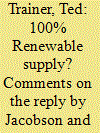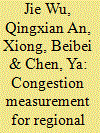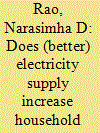|
|
|
Sort Order |
|
|
|
Items / Page
|
|
|
|
|
|
|
| Srl | Item |
| 1 |
ID:
121399


|
|
|
|
|
| Publication |
2013.
|
| Summary/Abstract |
I recently criticised the claim by Jacobson and Delucchi that renewable energy sources could meet world energy demand. Jacobson and Delucchi replied defending their position. This is a response to the main points made in that reply. The main issues are to do with intermittency of renewable energy sources and the implications for redundant plant and storage, vehicle to grid systems as a storage solution, the embodied energy costs of renewable energy, and overall system capital costs. It is argued that Jacobson and Delucchi do not provide satisfactory analyses of these issues and that they do not show that energy supply can be 100% renewable. This discussion is intended to clarify some of the core issues in the debate about the limits of renewable energy.
|
|
|
|
|
|
|
|
|
|
|
|
|
|
|
|
| 2 |
ID:
121395


|
|
|
|
|
| Publication |
2013.
|
| Summary/Abstract |
We investigate the impacts of the U.S. renewable fuel standard (RFS2) and several alternative biofuel policy designs on global GHG emissions from land use change and agriculture over the 2010-2030 horizon. Analysis of the scenarios relies on GLOBIOM, a global, multi-sectoral economic model based on a detailed representation of land use. Our results reveal that RFS2 would substantially increase the portion of agricultural land needed for biofuel feedstock production. U.S. exports of most agricultural products would decrease as long as the biofuel target would increase leading to higher land conversion and nitrogen use globally. In fact, higher levels of the mandate mean lower net emissions within the U.S. but when the emissions from the rest of the world are considered, the US biofuel policy results in almost no change on GHG emissions for the RFS2 level and higher global GHG emissions for higher levels of the mandate or higher share of conventional corn-ethanol in the mandate. Finally, we show that if the projected crop productivity would be lower globally, the imbalance between domestic U.S. GHG savings and additional GHG emissions in the rest of the world would increase, thus deteriorating the net global impact of U.S. biofuel policies.
|
|
|
|
|
|
|
|
|
|
|
|
|
|
|
|
| 3 |
ID:
121389


|
|
|
|
|
| Publication |
2013.
|
| Summary/Abstract |
Many people believe that China's economic growth can continue almost indefinitely. For a manufacturing-based economy such as China's to continue to grow, it needs an adequate supply of inexpensive energy. To date, this energy growth has primarily come from coal, but China's indigenous coal supplies are now falling short of the amount needed to support this growth. In this situation, the status of China's future coal supply will be very important for China's future economic development. Our analysis shows that China's ultimate recoverable coal reserves equal 223.6×109 MT, and its production will peak between 2025 and 2030, with peak production of approximately 3.9×109 MT. The extent to which China can import coal in the future is uncertain. With rising coal demand, this combination is likely to create a significant challenge to China's future economic development.
|
|
|
|
|
|
|
|
|
|
|
|
|
|
|
|
| 4 |
ID:
121377


|
|
|
|
|
| Publication |
2013.
|
| Summary/Abstract |
Interest in the role embodied energy plays in international trade and its subsequent impact on energy security has grown. As a developed nation, the UK's economic structure has changed from that of a primary producer to that of a primary consumer. Although the UK's energy consumption appears to have peaked, it imports a lot of energy embodied in international trade alongside the more obvious direct energy imports. The UK has seen increasing dependency on imported fossil energy since the UK became a net energy importer in 2005. In this paper an energy input-output model is established to calculate not only the amount of fossil energy embodied in UK's imports and exports, but also the sector and country distributions of those embodied fossil energy. The research results suggest the following: UK's embodied fossil energy imports have exceeded embodied fossil energy exports every year since 1997, UK embodied energy imports through the so-called 'Made in China' phenomena are the largest accounting for 43% of total net fossil energy imports. If net embodied fossil energy imports are considered, the gap between energy consumption and production in UK is much larger than commonly perceived, with subsequent implications to the UK's energy security.
|
|
|
|
|
|
|
|
|
|
|
|
|
|
|
|
| 5 |
ID:
121371


|
|
|
|
|
| Publication |
2013.
|
| Summary/Abstract |
Biofuels policies and projects may lead to environmental, economic and social impacts. A number of studies point out the need to deliver comprehensive sustainability assessments regarding biofuels, with some presenting analytical frameworks that claim to be exhaustive. However, what is often found in the literature is an overexploitation of environmental and economic concerns, by contrast to a limited appraisal of the social aspects of biofuels. Building on a systematic review of the peer-reviewed literature, this paper discusses the social constraints and strengths of ethanol, with regard to the product's lifecycle stages and the actors involved. Its objective is to contribute to the development of social frameworks to be used in assessing the impact of ethanol. Main findings indicate that ethanol developments can increase the levels of social vulnerability, although there is little evidence in the literature regarding the positive and negative social impacts of 1st-generation ethanol and potential impacts of cellulosic ethanol. Further work is needed on the formulation of social criteria and indicators for a comprehensive sustainability assessment of this biofuel. Policy makers need to internalise the social dimension of ethanol in decision-making to prevent public opposition and irreversible social costs in the future.
|
|
|
|
|
|
|
|
|
|
|
|
|
|
|
|
| 6 |
ID:
121361


|
|
|
|
|
| Publication |
2013.
|
| Summary/Abstract |
Hot Summer and Cold Winter (HSCW) region plays an important role in China's building energy conservation task due to its high consumption in recent years for both climate and social reasons. National and local building energy standards according to which the buildings are built and operated can affect the building energy consumption to a great extent. This study investigated the energy saving potential in Hot Summer and Cold Winter Zone under different level of energy efficiency standards (China local, China national, and UK standard). Chongqing was taken as an example, and the commercial energy simulation tool eQuest was applied to analyze the building end-use energy. With the existing situation as a baseline, the building energy saving for residential section could achieve 31.5% if the Chinese national standard were satisfied, and the value would further increase to 45.0% and 53.4% when the Chongqing local and UK standard were met. For public buildings, the corresponding energy saving potentials were 62.8%, 67.4% and 75.9%. Parameter sensitivity analysis was conducted. The analysis was able to provide suggestions on energy saving implementation priorities for residential and public buildings. Indications to improve building energy standards and their implementation were also discussed.
|
|
|
|
|
|
|
|
|
|
|
|
|
|
|
|
| 7 |
ID:
121365


|
|
|
|
|
| Publication |
2013.
|
| Summary/Abstract |
Industrial parks have become the effective strategies for government to promote sustainable economic development due to the following advantages: shared infrastructure and concentrated industrial activities within planned areas. However, due to intensive energy consumption and dependence on fossil fuels, industrial parks have become the main areas for greenhouse gas emissions. Therefore, it is critical to quantify their carbon footprints so that appropriate emission reduction policies can be raised. The objective of this paper is to seek an appropriate method on evaluating the carbon footprint of one industrial park. The tiered hybrid LCA method was selected due to its advantages over other methods. Shenyang Economic and Technological Development Zone (SETDZ), a typical comprehensive industrial park in China, was chosen as a case study park. The results show that the total life cycle carbon footprint of SETDZ was 15.29 Mt, including 6.81 Mt onsite (direct) carbon footprint, 8.47 Mt upstream carbon footprint, and only 3201 t downstream carbon footprint. Analysis from industrial sector perspectives shows that chemical industry and manufacture of general purpose machinery and special purposes machinery sector were the two largest sectors for life cycle carbon footprint. Such a sector analysis may be useful for investigation of appropriate emission reduction policies.
|
|
|
|
|
|
|
|
|
|
|
|
|
|
|
|
| 8 |
ID:
121386


|
|
|
|
|
| Publication |
2013.
|
| Summary/Abstract |
For a long time considered as technologically mature, electric systems are now facing a period of rapid evolution, inspired by climate change concerns. Several studies show that current regulation of natural monopolies does not offer sufficient incentives for network operators (and network users) to participate in this process.
Taking Italy as a case study, this paper analyses how energy regulation can change to support the current transformation. We describe the recent regulatory interventions in the domain of smart grids, smart metering and electromobility, with a specific emphasis on the provisions aimed at fostering innovation-an issue that until recently has received almost no attention in the literature nor in the practice of regulation.
The progress we observe is considerable in all new areas of concern, and, above all, in the regulator's commitment to provide the right incentives for investments in demonstration projects: the acquisition of experience is regarded as essential to move to more sophisticated regulatory instruments. Finally, regulation is also increasingly concerned with network users, both traditional and new, with the objective to stimulate more active behaviours.
|
|
|
|
|
|
|
|
|
|
|
|
|
|
|
|
| 9 |
ID:
121348


|
|
|
|
|
| Publication |
2013.
|
| Summary/Abstract |
Utilities are increasing their investment in smart grid technologies because of the rising demand for electricity, the aging transmission and distribution infrastructure in developed countries and the need for real-time visibility of energy supply and demand to optimize service reliability and cost. Government policies are contributing to this rising investment in the smart grid in many countries around the globe. Using Rothwell and Zegveld's innovation policy framework as a starting point, this paper compares innovation policy in smart grids across the Pacific; specifically, China and the USA. This research describes the policy tools used by both countries and presents results that indicate national preferences for innovation policy that differ in the ways in which they are linked with the state of the power system. China has preferred to use "supply-side policy," which focuses on "public enterprise, scientific and technical development and legal regulation." The USA has preferred to use "environmental-side policy," which focuses on "scientific and technical development, financial, political and public enterprise." This paper also describes in detail a number of innovation policies being pursued in the smart grid industry in both China and the USA.
|
|
|
|
|
|
|
|
|
|
|
|
|
|
|
|
| 10 |
ID:
121397


|
|
|
|
|
| Publication |
2013.
|
| Summary/Abstract |
The mitigation of greenhouse gas (GHG) emissions from power generation and two ethanol production options from sugarcane bagasse were compared at grid emission factors ranging from 0.0 to 1.0 kg of carbon dioxide (CO2) equivalent per kWh. The first ethanol production method (EP 1) directly purchased electricity and steam from the grid and the factory, and the second ethanol production method (EP 2) derived the required electricity and steam from the cogeneration system using the sugarcane bagasse as boiler fuel. Data pertaining to GHG emissions from power generation were collected from published studies. A process for ethanol production from sugarcane bagasse was designed, and a simulator was developed to generate the process data using Microsoft Excel. Results show that power generation is the preferential option when the grid emission factors are higher than 0.45 kg CO2 eq/kWh. The EP 1 was advantageous in mitigating the GHG emissions when the grid emission factors were lower than 0.19 kg CO2 eq/kWh, and the EP 2 might be the most environmentally beneficial when the grid emission factors were between 0.19 and 0.45 kg CO2 eq/kWh. It is hoped that these results could be helpful in determining how to best utilize sugarcane bagasse.
|
|
|
|
|
|
|
|
|
|
|
|
|
|
|
|
| 11 |
ID:
121333


|
|
|
|
|
| Publication |
2013.
|
| Summary/Abstract |
The industry in China has been developing extensively in the last few decades. Large investments in China's industry may cause congestion because congestion is a widely observed economic phenomenon in such a scenario. In order to know the performance and allocate resources well, it is necessary for the Chinese government to measure congestion of the industry. Many scholars have studied this topic by means of data envelopment analysis (DEA). However, previous studies only pay attention to the framework of desirable outputs. In fact, undesirable outputs often accompany desirable outputs in production. Thus, in this study, a new approach for measuring congestion with undesirable outputs is proposed and applied to analyzing congestion of the industry in 31 administrative regions of China. The results show that five regions have congestion in their industry in 2010. Besides, the regions located in the east of the country perform the best in ecological efficiency, followed by regions in central and west China. Based on these findings, this paper proposes some political schemes to improve regional industrial efficiency.
|
|
|
|
|
|
|
|
|
|
|
|
|
|
|
|
| 12 |
ID:
121391


|
|
|
|
|
| Publication |
2013.
|
| Summary/Abstract |
Trends in increasing urbanization, paired with a lack of ambitious action on larger scales, uniquely position cities to resume leadership roles in climate mitigation. While many cities have adopted ambitious long-term emission reduction goals, few have articulated how to reach them. This paper presents one of the first long-term scenarios of deep greenhouse gas abatement for a major U.S. city. Using a detailed, bottom-up scenario analysis, we investigate how Seattle might achieve its recently stated goal of carbon neutrality by the year 2050. The analysis demonstrates that a series of ambitious strategies could achieve per capita GHG reductions of 34% in 2020, and 91% in 2050 in Seattle's "core" emissions from the buildings, transportation, and waste sectors. We examine the pros and cons of options to get to, or beyond, net zero emissions in these sectors. We also discuss methodological innovations for community-scale emissions accounting frameworks, including a "core" emissions focus that excludes industrial activity and a consumption perspective that expands the emissions footprint and scope of policy solutions. As in Seattle, other communities may find the mitigation strategies and analytical approaches presented here are useful for crafting policies to achieve deep GHG-reduction goals.
|
|
|
|
|
|
|
|
|
|
|
|
|
|
|
|
| 13 |
ID:
121370


|
|
|
|
|
| Publication |
2013.
|
| Summary/Abstract |
A key challenge internationally is the design of future electricity systems which will bring about emissions savings and fuel security at least cost. Peat is used to generate electricity in several EU countries, mainly to take advantage of indigenous resources and increase fuel mix diversity. The Irish government has introduced a target of 30% cofiring of peat and biomass by 2015. This paper assesses the feasibility of achieving this target by calculating the available indigenous biomass resource capable of being cofired; the cost of meeting the target; the benefits in terms of carbon abatement; and finally the present value in economic terms of meeting the target. Results demonstrate that Ireland has only half the necessary resource to meet the 30% target and that the net cost of doing so is greater than the cost of what is currently being paid for peat, in all of the scenarios considered. Thus, it is concluded that while it may be technically possible to meet the target by combining national resources with imported biomass this is never the least cost option, and as a result the targeted focus of Government policy may need to be reconsidered.
|
|
|
|
|
|
|
|
|
|
|
|
|
|
|
|
| 14 |
ID:
121390


|
|
|
|
|
| Publication |
2013.
|
| Summary/Abstract |
The fulfilment of the aims set by the European Union in the deployment of renewable energy sources for electricity generation (RES-E) has counted and must continue to count on public funding from the member states, which promote private investment in this type of facilities. This funding guarantees a cost-oriented remuneration which, being higher than the market price means an additional cost to the electricity system. With the aim of minimizing the economic impact as the weight of RES-E in the electricity mix increases, the generation costs of renewable units must approach those of the market, which are expected to increase according to the fossil fuel price forecasts. The present study analyzes both the RES-E development and deployment in Spain and Germany, two pioneering countries worldwide and with very similar electricity systems. Based on their national action plans and a simple model, this analysis approaches the RES-E surcharge, comparing and contrasting the results obtained in both countries.
|
|
|
|
|
|
|
|
|
|
|
|
|
|
|
|
| 15 |
ID:
121355


|
|
|
|
|
| Publication |
2013.
|
| Summary/Abstract |
The new federal government in the German federal state of Baden-Württemberg has set a target for 10% of gross electricity generation from wind energy by 2020. Given that currently around 0.1% of the electricity generation comes from wind energy, this paper examines the technical feasibility and economic costs associated with realising this goal. The technical potential for wind energy in Baden-Württemberg is determined, along with the costs of electricity generation, which together lead to the derivation of cost-potential-curves. The technical potential is calculated by identifying the available area with the aid of a geographical information system (GIS) and land use information. With the help of a regional wind atlas, turbine power curves and an assumed wind speed frequency distribution, the spatially distributed electricity generation potential on a district level is estimated. The costs of wind energy are investigated for the year 2010 and projected for the years 2020 and 2030 on the basis of learning curves. The result is a suitable area for wind energy of 2119 km², which amounts to 5.9% of the total area of Baden-Württemberg. Depending on the wind turbine selected, a capacity of 18.5 GW up to 24.5 GW could be installed and depending on the hub height and the turbine, an electricity yield of 29.3 TWh up to 40.7 TWh could be generated. The costs of electricity, depending on the type of turbine and the average wind speed, but lie for 2010 between 3.99 and 21.42 €-cents/kWh, reducing by 2030 to 3.33-17.84 €-cents/kWh.
|
|
|
|
|
|
|
|
|
|
|
|
|
|
|
|
| 16 |
ID:
121388


|
|
|
|
|
| Publication |
2013.
|
| Summary/Abstract |
Electricity access is an important driver of economic development. Previous studies treat electrification as a binary outcome. In reality, in developing countries households with access face chronic supply interruptions, which can last up to 12 h a day. This is the first study to estimate the income differences in urban and rural non-farm enterprises in Indian households with different levels of electricity supply, using a subset of 8125 households in the India Human and Development Survey, a cross-sectional national sample of 41,554 households. I use multiple econometric approaches, including linear regression with an instrument variable and propensity-score matching with multiple treatment levels to represent supply availability. I find a robust income effect of access, and suggestive evidence of the effect of better supply availability. The aggregate income impact across existing NFEs in India of improving supply to 16 h a day could be on the order of 0.1 percent of GDP.
|
|
|
|
|
|
|
|
|
|
|
|
|
|
|
|
| 17 |
ID:
121350


|
|
|
|
|
| Publication |
2013.
|
| Summary/Abstract |
In this paper, we use wavelet analysis to investigate the cyclical comovements between crude oil prices and US GDP, taking into account the decline in the volatility of US GDP growth that has occurred since the mid-1980s.
Our main findings suggest that before 1984:Q1, the crude oil prices were leading the US GDP cycle by 3 quarters and Granger cause US GDP. In contrast, after 1984:Q1, the crude oil prices were lagging the US business cycle, and a reverse causality is found to run from US GDP to oil prices. The multiscale Granger causality tests globally corroborate theses results.
|
|
|
|
|
|
|
|
|
|
|
|
|
|
|
|
| 18 |
ID:
121351


|
|
|
|
|
| Publication |
2013.
|
| Summary/Abstract |
Ecuador's energy policy faces a complex variety of political and economic objectives that are difficult to reconcile in a consistent manner. Ecuador is a small oil producer and exporter with significant renewable (mainly hydropower) resources, hosting some of the richest biodiversity areas in the world, part of which are inhabited by so far indigenous un-contacted people. Being a developing country, tensions arise between conservation aims and development imperatives, as well as between resource nationalism and much-needed foreign financing. However, the really limiting factor for the country's energy development seems to be its constraints in financing the government's development and redistributive policies. Resorting to Chinese loans-for-oil may be part of the solution in the short term, but it does not substitute for a more consistent energy policy. Ecuador's case illustrates the dilemmas of energy policy in natural resource-rich developing countries when confronted with diverging political economy, social, environmental and macro-financial goals.
|
|
|
|
|
|
|
|
|
|
|
|
|
|
|
|
| 19 |
ID:
121340


|
|
|
|
|
| Publication |
2013.
|
| Summary/Abstract |
The paper focuses on a so-called emission-dependent supply chain consisting of one single emission-dependent manufacturer and one single emission permit supplier in the 'cap-and-trade' system, where emission permit becomes requisite for production. We consider the emission cap of emission-dependent manufacturer allocated by the government as a kind of environmental policy and formally investigate its influence on decision-makings within the concerned emission-dependent supply chain as well as distribution fairness in social welfare. It is proved that the system-wide and the manufacturer's profits increase with the emission cap while the permit supplier's decreases. There is room for manufacturer and permit supplier to coordinate the supply chain to get more profit in a certain condition.
|
|
|
|
|
|
|
|
|
|
|
|
|
|
|
|
| 20 |
ID:
121337


|
|
|
|
|
| Publication |
2013.
|
| Summary/Abstract |
Corporate excessive energy consumption and emissions are negative externality problems, with the basic countermeasure of establishing a series of institutional programs to promote corporate energy conservation and emissions reduction. This paper analyzes the influence of institutional factors such as laws, tax policies, credit policies, government subsidies, media supervision and marketization degree on corporate energy conservation and emissions reduction from the institutional perspective. The data, from 84 listed Chinese chemical and steel companies from 2006 to 2010, was analyzed using both a fixed effect model and the generalized method of moments (GMM) model. The empirical results demonstrate that these institutional factors positively affect corporate energy conservation and emissions reduction. Specifically, four factors - tax policies, government subsidies, credit policies and media supervision - have a significant positive relationship with corporate energy conservation and emissions reduction; whereas laws and marketization degree exhibit no significant effects. The research findings are theoretically and practically significant to the Chinese government with regard to improving the institutional environment and promoting corporate energy conservation and emissions reduction.
|
|
|
|
|
|
|
|
|
|
|
|
|
|
|
|
|
|
|
|
|